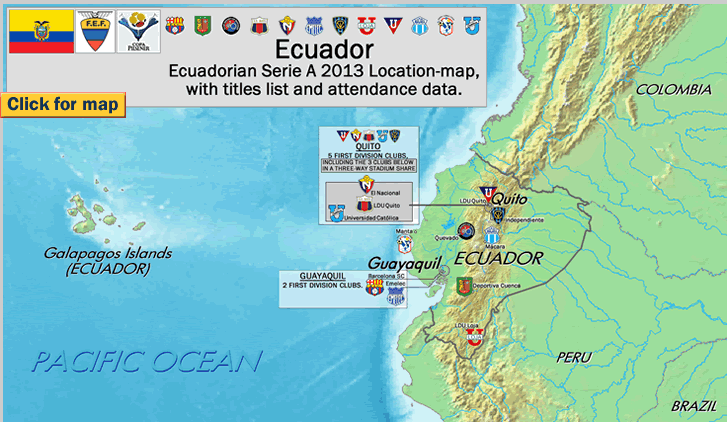
Ecuadorian Primera Categoría Serie A – location-map for 2013 season, with titles list & attendance data
…
…
Ecuador, as its name implies, sits right on the equator in the north-western part of South America. Ecuador is a medium/small-sized mountainous country with ample coastline on the Pacific Ocean, bordering Colombia to the north and Peru to the east and south. Included in the territory of the nation of Ecuador is the singular eco-tourist mecca which is the Galápagos Islands, where around 180 years ago naturalist Charles Darwin spent crucial time during the ‘Second voyage of HMS Beagle [1831-36]‘ leading to his theory of evolution by natural selection, and where today giant tortoises and blue-footed boobies and marine iguanas thrive. The Galapagos are located about 1,000 km. (620 mi.) due west of the Ecuadorian mainland. Here is an excerpt from ‘Ecuador‘ at en.wikipedia.org … ‘ Ecuador is also home to a great variety of species, many of them endemic, like those of the Galápagos islands. This species diversity makes Ecuador one of the 17 megadiverse countries in the world. The new constitution of 2008 is the first in the world to recognize legally enforceable Rights of Nature, or ecosystem rights.’…{end of excerpt}. (en.wikipedia.org).
In 1979, Ecuador returned to democracy after 8 years of rule by 2 different military juntas, when, following civil pressure, Ecuador held democratic elections. After 3 changes of power, the country has remained a representative democracy with a president at its head, but, owing to several factors including the destabilizing effects from both the elites and from leftist movements, the presidency is a weakened and ineffective position in Ecuador. As it says here, at Freedom House.org, …’since 1998, three presidents have been forced from office before the conclusion of their terms as a result of popular protests and congressional action’. (freedomhouse.org/report/freedom-world/2012/ecuador).
By size, Ecuador is just about the same size as the US state of Oregon, or slightly smaller than New Zealand and slightly larger than Romania – at 266,000 km-squared (or 98,985 sq. mi.), making it the 78th-largest country in the world {country-size data, here (en.wikipedia.org)}. As to Ecuador’s GDP, on a per-capita basis, Ecuador currently [April 2013] is ranked #64 in the world, and in local-comparison-terms, considerably lower than Colombia and Venezuela (#s 33 and 34, currently), and a bit lower than Peru (#53, currently) {GDP data, here (en.wikipedia.org)}.
Ecuador’s population is around 14.4 million, and its 2 largest cities are the port city of Guayaquil {city pop. around 2.3 million}, and the high-elevation capital city of Quito {city pop. around 1.6 million} {population figures from 2010 census, here}. Quito is the highest-elevation national capital in the world, at 2,800 metres or 9,850 feet. That is 1.8 miles high or 3 kilometres high.
…
Ecuador national football team

Chart above from en.wikipedia.org/2014_FIFA World Cup qualification (CONMEBOL), here.
Ecuador did not enter a qualifying tournament for the World Cup until the late 1950s, with the 1962 FIFA World Cup being the first World Cup that Ecuador tried to qualify for. That was 5 years after Ecuador finally formed a professional national football league (in 1957, see further below). Ecuador’s men’s national football team has qualified for just 2 FIFA World Cup tournaments, although both times in which they qualified were relatively recent – in 2002 and 2006. In 2002 in Japan/South Korea, Ecuador were eliminated in the Group Stage. In 2006, in Germany, Ecuador made it to the Round of 16 (beating Poland and Costa Rica en route to being eliminated by England).
Currently, Ecuador are in a very good position to qualify for the 2014 FIFA World Cup in Brazil, seeing as how they are in second place in the South American WC qualifiers, 5 points and 3 teams above the cut-off, with a game in hand {CONMEBOL/South American WC qualifiers, fixtures, results, table, here (en.wikipedia.org)}. Argentina leads the South American World Cup qualifiers with 24 points, and Ecuador is in second with 20 points. Ten or eleven of 16 matches per team have been played, and the top 4 automatically go to the World Cup (5th plays Oceania winner), and Brazil is already in as host, so Ecuador are positioned nicely and their high-altitude home field advantage at Estadio Atuahalpa in Quito will continue to give them an extra edge on most visiting sides. Ecuador are 6-0 at home in the 2014 WC qualifiers. They just dismantled Paraguay 4-1, before a capacity crowd of around 30,000 in Quito on 26 March. Goals were scored by MF Jefferson Montero (who had a brace), FW Felipe Caicedo, and FW Christian Benítez. Ecuador is a team that is chock-full of technically-adept speedsters – it seems like every squad member, even all the defenders, have pace. Ecuador pose a big threat on the counter-attack, while it looks like their weak point is in defense. Ecuador are coached by Colombian-born former Honduras national team coach Reinaldo Rueda. Rueda made his mark in 2010 by getting the unheralded Honduran national team into the FIFA World Cup for only their second time (Honduras also had qualified for the 1982 World Cup in Spain).
Below is a captioned illustration of 3 of the more highly-touted players currently playing for the Ecuador national team – Manchester United winger Antonio Valencia, Borussia Dortmund transfer target and current Lokomotiv Moscow striker Felipe Caicedo, and Wigan transfer target and current Monarcas Morelia (of Mexico) midfielder Jefferson Montero.
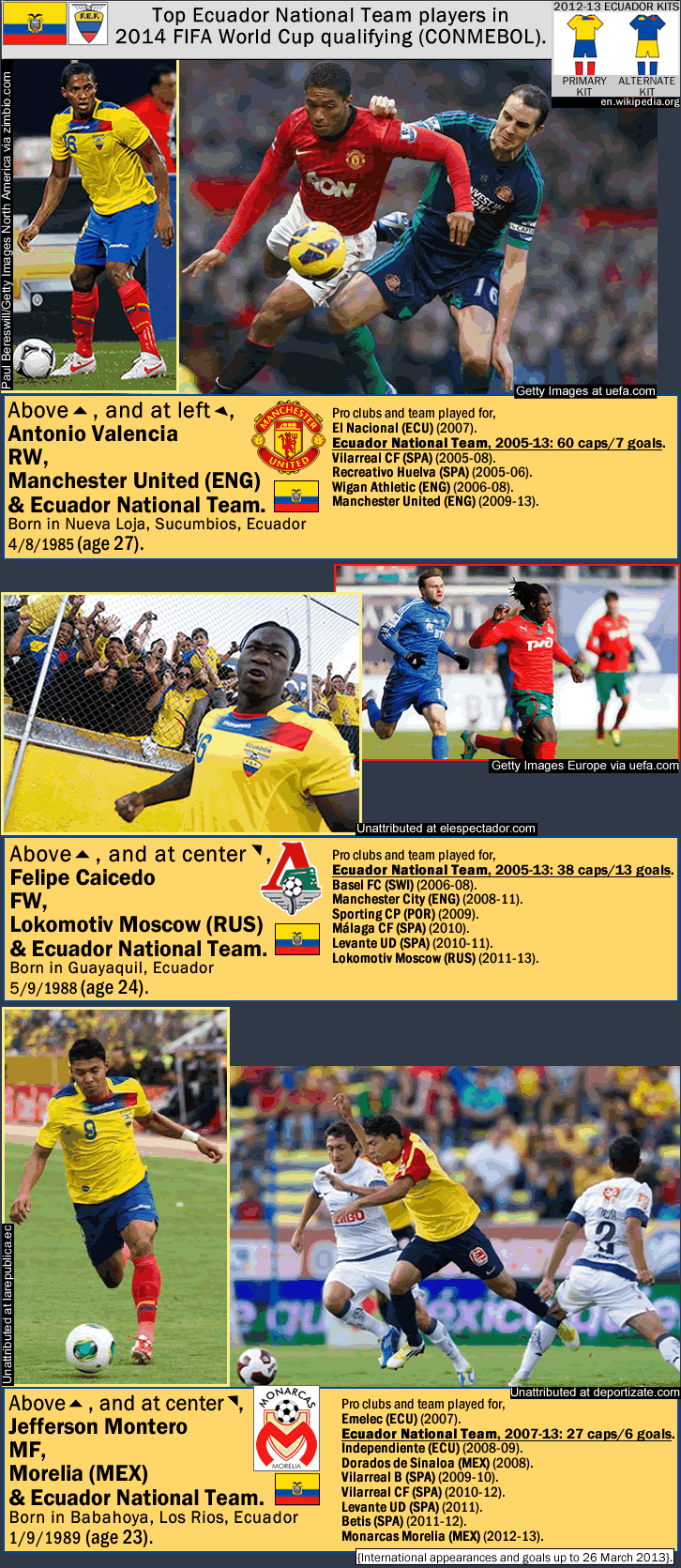
Photo and Image credits above -
‘Ecuador national football team‘ (en.wikipedia.org).
Getty Images at uefa.com.
Unattributed at elespectador.com.
Getty Images via uefa.com.
Paul Bereswill/Getty Images North America via zimbio.com.
Unattributed at larepublica.ec/blog/deportes.
Unattributed at deportizate.com.
…
The Ecuadorian professional first division – Ecuadorian Primera Categoría Serie A
‘Ecuador – Primera A [Serie A], fixtures, results, table‘ (int.soccerway.com/ecuador).
‘Ecuador – Primera Etapa overview [including attendances]‘ (worldfootball.net/ecu-campeonato).
The Ecuadorian professional first division was established in 1957. The current format, called Ecuadorian Primera Categoría Serie A, has 12 teams playing 2 half seasons of 22 games each. The season runs from February to December (with the first half-season ending in June). The two half-season winners then face off in a 2-match finals in mid-December (unless the same club wins both halves of the season, like Barcelona SC did in 2012). 2 clubs (11th and 12th places aggregate) are relegated each season to Serie B, and at the end of each season, 2 are promoted up from the Ecuadorian Serie B.
Current champions are the biggest club in Ecuador, Barcelona Sporting Club, who are of course named after the Catalan giants and are from Guayaquil. Barcelona SC average around 20 to 25,000 per game in a good year or 8 to 15,000 per game or so in a bad year. Barcelona SC, formed in 1925, have the most Ecuadorian pro titles, with 14 (but they had not won a title in 15 years prior to last season, and their attendance really slumped circa 2009-2010). Barcelona SC own their own stadium, Estadio Monumental, which was opened in 1987 and at just over 80,600-capacity is one of the largest football stadiums in the world {see this, from 2010 at the Offside.com, ‘The 10 Biggest Football (or Soccer) Stadiums in the World‘. Barcelona SC averaged 24,066 per game in 2012, which was more than double the crowd-size of any other team in the country last year.
After Barcelona SC, the fan-base-size of the next-largest Ecuadorian clubs shrinks to the 7,000 to 13,000 per game range, with 2 clubs fitting this category, both of whom are over 85 years old, and both of whom are tied for the third-most national pro titles with 10 apiece… Quito’s LDU Quito, established in 1930, and who are the only Ecuadorian club to have won a Copa Libertadores title (in 2007); and Guayaquil’s Emelec, who were established in 1929. Both these clubs also own their own stadiums. LDU Quito’s stadium, Casa Blanca, was opened in 1997 and has a capacity of 55,000. Emelec’s Estadio George Capwell, which was built in 1945 and was last renovated in 1991, has a capacity of 24,000, mostly in steep stands that make it look like an Argentinian football ground. Estadio George Capwell is named after the US-born engineer and founder of the electrical company in the late 1920s from which the club sprung from (see Emelec illustration further below for etymology of their name). Estadio George Capwell might have seen better days, but that tight cauldron is an atmosphere-charged home-field-advantage for Emelec for sure (you can see what I mean about the atmosphere at Estadio George Capwell if you scroll down to the next paragraph and check out the 3:00 video highlights of Emelec’s recent 2-0 win over Peñarol in the 2013 Copa Libertadores). Emelec averaged 8,888 per game last season (which was second-best in Ecuador); LDU Quito averaged 8,502 per game last season (3rd best).
[Side-note:
Emelec are the only Ecuadorian club currently with a shot at advancing to the 2013 Copa Librtadores Round of 16. On Tuesday, the 2nd of April, before 22,000 at Estadio George Capwell in Guayaquil, Emelec scored two late goals (both from set plays) against Peñarol to win 2-0 and take a 3-point lead over Peñarol for the final advancing-spot in their group (see this, (en.wikipedia.org/2013 Copa Libertadores, Second Stage). If Emelec draw in their final match away against group-winners Vélez Sarsfield they will advance, but Emelec can also advance if they can maintain their better goal difference (currently at +1 g.d for Emelec, versus Peñarol's -3 g.d.). Video highlights can be seen at the following link (via eluniverso.com, 'Copa Libertadores: Emelec 2-0 Peñarol (Tomado de Fox Sports)' (youtube.com; 3:00 video uploaded by eluniverso.com) / original article here, 'Emelec venció 2-0 a Peñarol y se acerca a los octavos de la Copa Libertadores' (eluniverso.com). ]
…
So the 3 biggest clubs in Ecuador all own their own stadiums. Two of those venues might be too big, and the other one is in need of a refurbishing, but still, 3 clubs out of 12 owning their own stadium is not too bad compared to some countries (like Italy, at 1 for 20 currently). The 3 biggest clubs in Ecuador show there is the capability there, as in places like Germany, the Netherlands, England, and Spain (and to a lesser degree in countries like Brazil, Argentina, and Portugal), of clubs being able to build and own their own football grounds.
Elsewhere in Ecuadorian football, there is still the reliance by clubs for local municipalities or national government agencies to do the inevitably poor job of building god-awful stadiums. Stadiums with a wide bowl-shaped single encircling stand (at a shallow incline), and poor sight-lines and vast distances from the stands to the pitch, thanks to a useless, atmosphere-destroying running track. However, there are several exceptions to this in Ecuador, with 3 decent (though admittedly spartan) municipal stadiums in provincial cities in Ecuador. The 18,000-capacity Estadio Bellavista in Ambato (home of yo-yo club Macará, and also home of the recently-relegated Técnico Universitario); the 15,000-capacity municipal Estadio Jocay in the coastal city of Manta (home to Manta FC); and the 16,000-capacity municipal stadium Estadio 7 de Octubre in Quevado (home of the recently-promoted Deportivo Quevado). All 3 of these stadiums are, like many French or some Spanish municipal stadiums, built with nice and steep-angled stands that are often extremely close to the pitch and with no running track {see a couple photos of Estadio Bellavista in Ambato here (europlan-online.de)}; {see a photo of Estadio Jocay in Manta here (soccerway.com){; {see a photo of Estadio 7 de Octubre in Quevado here/click on photo there to enlarge (lahora.com).
As to the second-most titled club in Ecuador, well, El Nacional didn’t get the memo, because they never tried to build their own stadium, and ever since they were formed in 1964 they have played in a soul-less bowl-shaped government-sports-agency-built stadium in Quito with a running track, now currently in a three-way stadium share at Estadio Olímpico Atahualpa. As it says about Estadio Olimpico Atualhalpa at the Football in the Clouds blog, …’It is a big concrete block of a structure which looks like the home of a Soviet Bloc team or nation’… {full article here, ‘New stadium plans in Quito’ (footballintheclouds.com)}.
So its no surprise that El Nacional, as successful as they are, have never been able to establish much of a fan base and a good average crowd size, at least not on a consistent basis – in bad seasons, El Nacional struggle to even reach 4,000 per game (like in 2012, when they averaged only 3,977 per game). Granted, at 49 years old, El Nacional are not really a very old club, so maybe it could be argued that they have been unable to build a bigger fan base because they are about half as old as venerable Ecuadorian clubs like Barcelona SC or Emelec or LDU Quito. In a good season, El Nacional can draw up to near the 8,000 per game range, as in 2011 when they were in the running for the title (eventually finishing fourth and drawing 7,206 per game).
Rounding out the clubs that can, in a good season, draw above average in Ecuador, there are, in addition to El Nacional, 5 other clubs which can draw between 3,500 and 8,000 per game – the relatively-new-club-and recently promoted club from the south of Ecuador, LDU Loja; the recently-relegated Technico Universitario; Deportivo Cuenca; Deportivo Quito;, and Macará. Two of these clubs have won Ecuadorian titles – Deportivo Quito has won 5 titles (last in 2011); and Cuenca has won 1 title (in 2004). Of the other three, LDU Loja, from Loja, the current southern-most club in the Ecuadorian top flight, deserve mention as they draw best of all the provincial clubs in the country. To see a photo of LDU Loja’s municipal stadium, the 15,000-capacity Estadio Federativo Reina del Cisne, {click here [and scroll down the page half-way to see the enlargeable photo]} (ceroacero.es). LDU Loja are a pretty new club (est. 1987), and first made it to the top flight in 2005. Despite their unremarkable municipal stadium, Loja can draw between 6 and 9,000 per game – in 2010 they won promotion back to the first division and in 2011 drew 8,844 per game; last season Loja drew 6,332 per game, which was fourth-best in Ecuador. Although there a several other clubs in Loja (population of around 215,000 in the metro area {2010 figure}), LDU Loja are the only club from the city who have been in the first division.
…
(Note: the Ecuadorian pro fútbol titles list (1957 to 2012) is on the map page).
Below are captioned illustrations of all the clubs in the 2013 Ecuadorian Primera Categoría Serie A which have won national titles (6 clubs)…
Current first division clubs in Ecuador with national professional titles…
Barcelona SC. Estadio Monumental, Guayaquil.14 Ecuadorian titles (last in 2012).
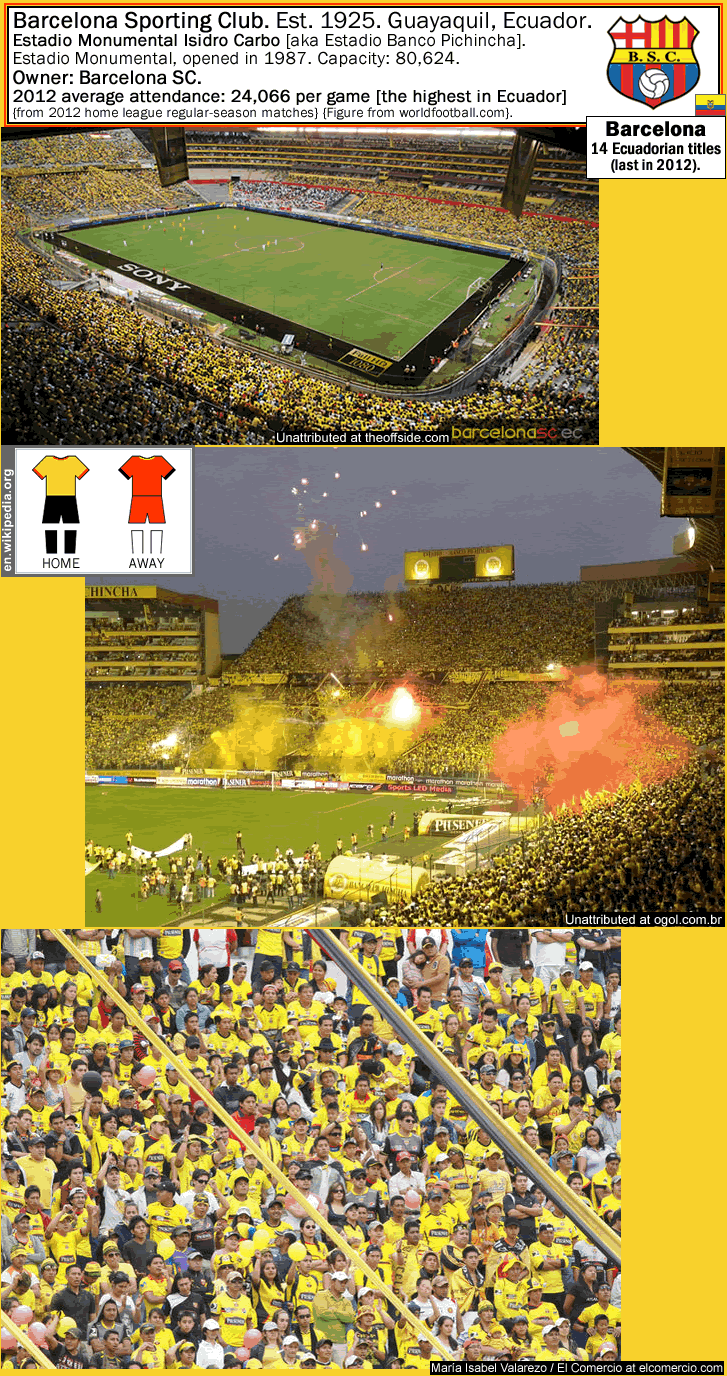
Photo and Image credits above -
Unattributed at theoffside.com/world-football/the-10-biggest-football-or-soccer-stadiums-in-the-world.
Unattributed at ogol.com.br/estadio.
‘Barcelona Sporting Club‘ (en.wikipedia.org).
María Isabel Valarezo / EL COMERCIO at elcomercio.com/deportes/futbol/futbol_ecuatoriano-El_Nacional-Barcelona_Sporting_Club-futbol .
…
El Nacional. Estadio Olímpico Atahualpa, Quito. 13 Ecuadorian titles (last in Clausura-2005).

Photo and Image credits above -
Unattributed at kentuckyecuadorpartners.blogspot.com.
‘Club Deportivo El Nacional‘ en.wikipedia.org).
Unattributed at eurorivals.net.
…
Emelec. Estadio George Capwell, Guayaquil. 10 Ecuadorian titles (last in 2002).
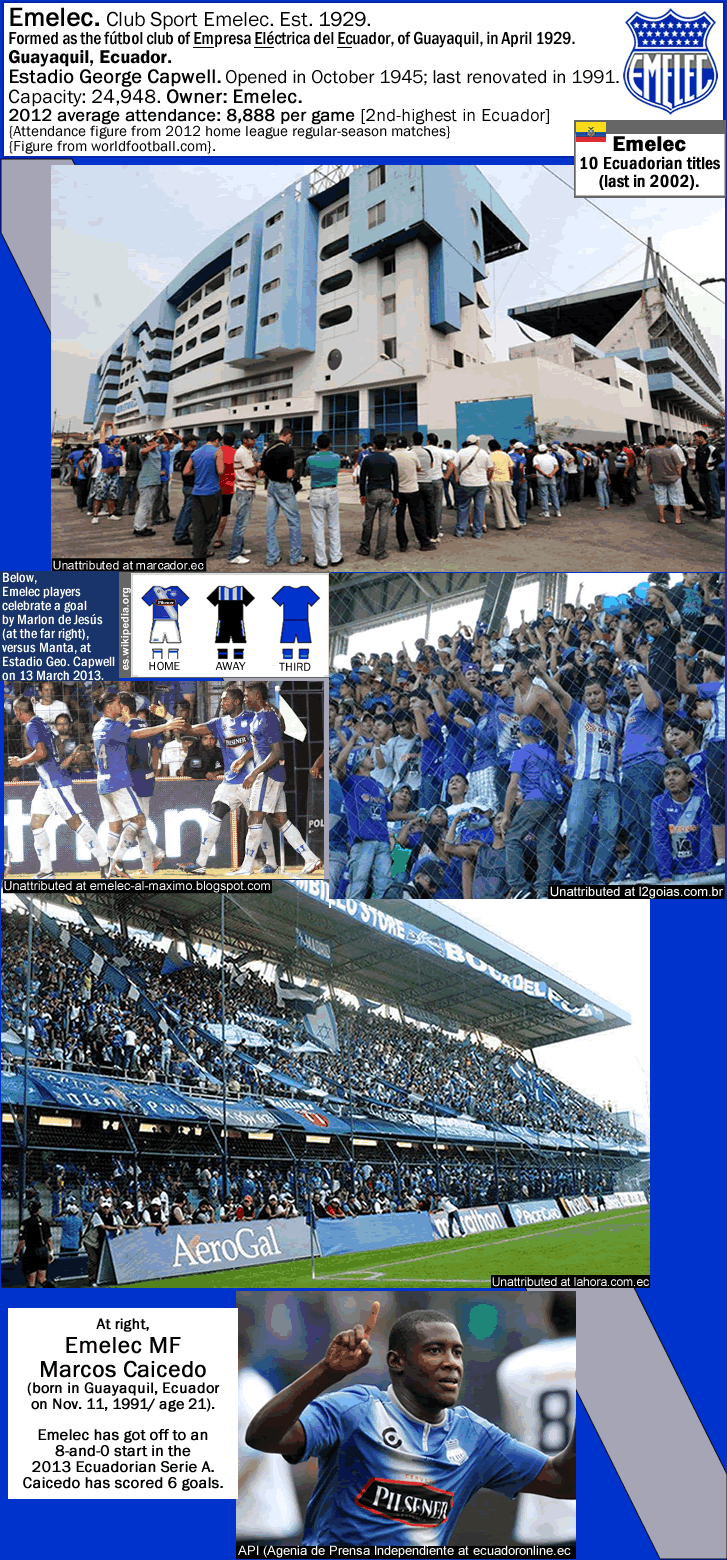
Photo and Image credits above -
Unattributed at marcador.ec .
Unattributed at emelec-al-maximo.blogspot.com.
‘Club Sport Emelec‘ (es.wikipedia.org).
Unattributed at l2goias.com.br.
Unattributed at lahora.com.ec.
API (Agencia de Prensa Independiente) at ecuadoronline.ec.
…
LDU Quito. Estadio de Liga Deportiva Universitaria [aka la Casa Blanaca (the White House)]. 10 Ecuadorian titles (last in 2010).
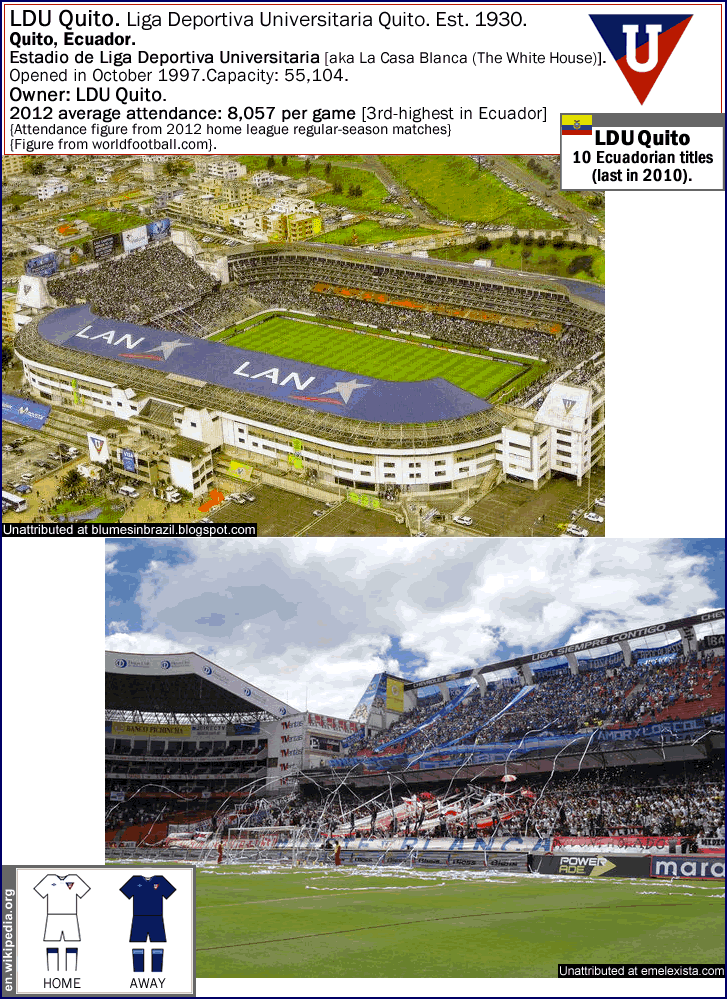
Photo and Image credits above -
Unattributed at blumesinbrazil.blogspot.com.
Unattributed at emelexista.com.
‘Liga Deportiva Universitaria de Quito‘ (en.wikipedia.org).
…
Deportivo Quito. Estadio Olímpico Atahualpa, Quito. 5 Ecuadorian titles (last in 2011).
‘Deportivo Quito‘ (en.wikipedia.org).
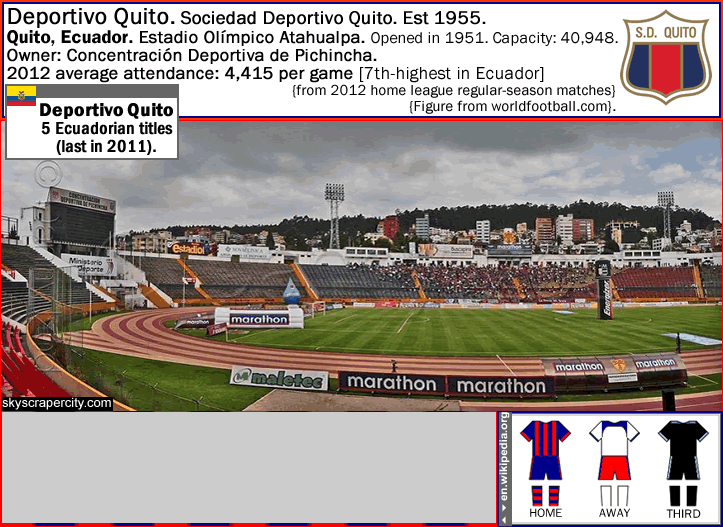
Photo and Image credits above -
Unattributed photo uploaded by Inkandrew9 at skyscrapercity.com [Ecuador stadiums thread].
‘Deportivo Quito‘ (en.wikipedia.org).
…
Deportivo Cuenca. Estadio Alejandro Serrano Aguilar, Cuenca, Azuay Province. 1 Ecuadorian title (in 2004).
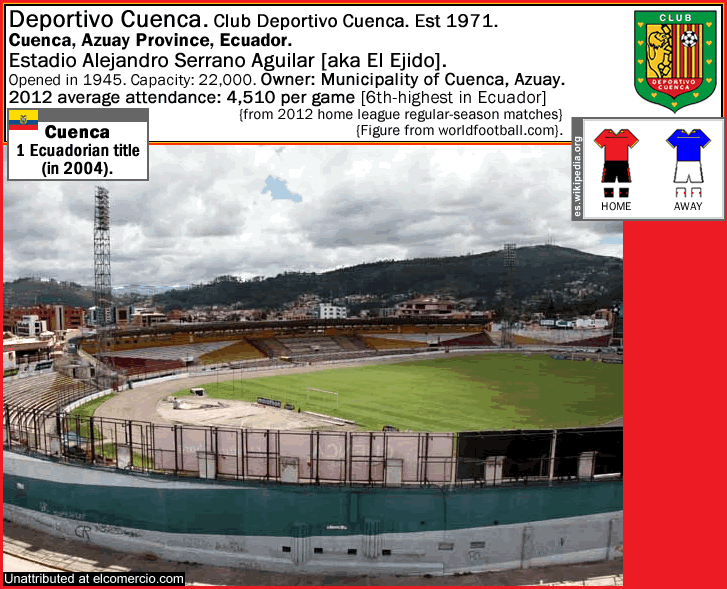
Photo and Image credits above -
‘Club Deportivo Cuenca (Ecuador)‘ (http://es.wikipedia.org).
Unattributed at elcomercio.com.
___
Thanks to the contributors to the pages at en. and es.wikipedia.org, ‘2013 Campeonato Ecuatoriano de Fútbol Serie A‘.
Thanks to Demis.nl – base map from demis.nl at Demis Web Map Server, demis.nl/home/pages/wms/demiswms.htm.
Thanks to WordldFootball.net for the attendance figures, worldfootball.net/wettbewerb/ecu-campeonato.










